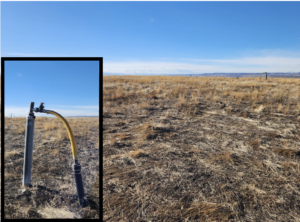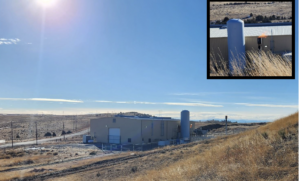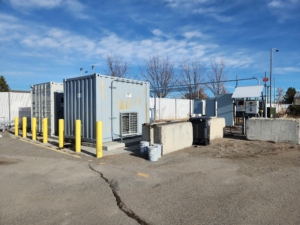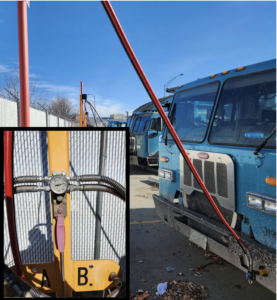With a start-up date of December 2010 and at a cost of $10 million, this Renewable Natural Gas (RNG) plant has been in operation for more than 12 years. According to an article published in 2014, the Billings landfill was generating enough RNG to heat 1,400 homes. Montana-Dakota Utilities (MTU) owns the RNG system and in 2013, the city received $55,000 in gas sales revenue which was 15% of the total profits of almost $370,000. In 2015, the city’s share of the profits was $250,000. In 2019, pulling 500,000 cubic feet of methane per day from 43 vertical wells, MTU laid another large horizontal culvert that will collect methane in a currently active part of the landfill. During my visit, they were installing the vertical wells on this portion of the landfill. Billings solid waste started with 2 RNG trucks and has since expanded to 14. This RNG plant appears to be the only one in Montana, Wyoming or North Dakota. My visit in early January 2023 allowed me to tour the landfill and see the RNG trucks and gas filling apparatus. Daniel Martinez, the Solid Waste Supervisor, was an experienced collection truck driver before taking on his new role and had a great perspective from both these positions. He graciously drove me around the landfill and the operation center that afternoon.
The following is what I learned from my tour:
Gas is collected from the capped landfill through dozens of wells spread out evenly and visible far off in the distance. You can hear the gas flowing through the pipes as you stand next to them. As Daniel Martinez, one of the Solid Waste Supervisors, points to the newly capped portion of the landfill down the “hill” from where we are he explains that they’ve recently installed even more of these collectors pipes.
Down the “hill”, at the edge of the landfill, sits the main RNG building. We weren’t able to tour this building, but it seems this is where all the collected gas is likely cleaned up and slightly compressed. Information from a 2012 document found on the EPA’s website, indicates the gas is cleaned with molecular gates for N2 and CO2 removal and TSA dehydration units. There appears to be a large storage tank there with a nearby vent pipe flaring off the flammable waste gasses.
The offices and maintenance garages (operation center) are across the Yellowstone River and I-90 just under 3 miles away. The RNG is transported through underground natural gas pipelines owned by Montana-Dakota Utilities before being delivered throughout the town.
At the operations center, there are compressors housed in two smaller shipping containers just upstream of what looks like a drying skid. The compressors come on automatically as trucks are being filled. The gas travels though this equipment before heading down very simple stainless steel plumbing to a basic regulator attached to a ball valve controlling the filling hoses.
The gas pressure is split evenly among all the filling towers. It can take 4-5 hours to fill from empty when all trucks are filling at the same time. However, if only one truck is being filled, it is much faster as the pressure is higher. Often, at the end of the day, the trucks are left to fill and are all full first thing in the morning.
The major noticeable benefit of RNG powered trucks when compared to their diesel counterparts is that there is no smoke coming from the exhaust pipe, only moisture. This also translates into far fewer visits to the mechanics in the shop compared to the diesels. Diesels are in the shop most often because of “check engine” lights triggered by emission hardware issues which the RNG trucks do not have.
These trucks aren’t without issues of their own. In the colder winter months, these trucks need to be plugged in and also have fuel filter issues, just like the diesels. The cold weather fuel issues are slightly different and are usually related to the metal fuel filter housings striking and allowing some RNG to escape making them harder to start. Some of the other concerns the drivers of these RNG trucks have is: 1) slightly lower power for both driving and the hydraulic pumps. With the current tank setup, the range of the RNG trucks is less than the diesels making them less versatile and unable to operate on all collection routes.
While there is a premium for CNG trucks of maybe $80,000, some of that is made up by fewer visits to the shop and of course by the “free” fuel on site.
Other notes:
Cold weather issues
- Still plug them in like diesel
- truck are stored outside because of possible CNG leaks (harder starting)
- fuel filters “gel up” when it’s really cold and can leak because the filter loosens in the cold.
Driver (Dan) says improvements could be
- No smoke from exhaust, only moisture
- Higher hydraulic pressure (might be lower because trucks don’t have as much power on CNG?)
- extra CNG tank to extend operating time and reduce mid-day fill ups
- CNG trucks have lower torque compared to diesel. Results in slower stop and goes adding 1 or 2 seconds per stop over 1000+ stops
Mechanics
- 10 fold fewer check engine lights in CNG trucks vs. Diesel (mainly emission stuff)
- Change spark plugs quite often
- have to “drain” all CNG before working on fuel system
- CNG trucks are ~$80k more than diesel and probably resell for less
- Longmont Wastewater CNG: https://afdc.energy.gov/case/3115
Billings 2014 article:
https://www.wastedive.com/news/billings-mo-takes-cng-trucks-for-a-spin/230030/






